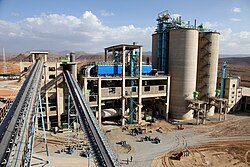Cement
Cement is a material that hardens and sticks to other materials to hold them together. Portland cement is a common kind, and made from quicklime (heated limestone) and clay. Cement is used to make concrete and mortar. Cement is widely used for plastering and rendering. Plastering is done for the inner walls, and cement rendering is done for the exterior walls. Cement rendering is also used to clad brickwork on either exterior, interior, or boundary walls.[1] This keeps brickwork protected from rain and water.
Joseph Aspdin developed Portland cement in the 19th century. He heated ground limestone and clay mix and then pulverized the mixture into fine powder.[2] In 1824 he also obtained a patent for his creation. Portland cement is suitable for wet climates and can be used underwater.
The global cement market is estimated to be around $340 billion. China is the top cement producer, followed by India and the USA.[3] The rising population is driving the cement demand. Countries in Asia, the Middle East, and Africa are improving their infrastructure which is resulting in the growth of the global cement industry.
Cement Media
Clinker nodules produced by sintering at 1450 °C
Calcium oxide obtained by thermal decomposition of calcium carbonate at high temperature (above 825 °C).
William Aspdin is considered the inventor of "modern" Portland cement.
References
- ↑ "Applications of Cement Render for Your House". Cement Render.
- ↑ "History of Cement | Construction Materials". www.cemexusa.com. Retrieved 2023-02-25.
- ↑ "Cement Market Size, Share | Global Industry Trends, 2022-2029". www.fortunebusinessinsights.com. Retrieved 2023-02-25.
| Wikimedia Commons has media related to Lua error in Module:Commons_link at line 62: attempt to index field 'wikibase' (a nil value).. |









